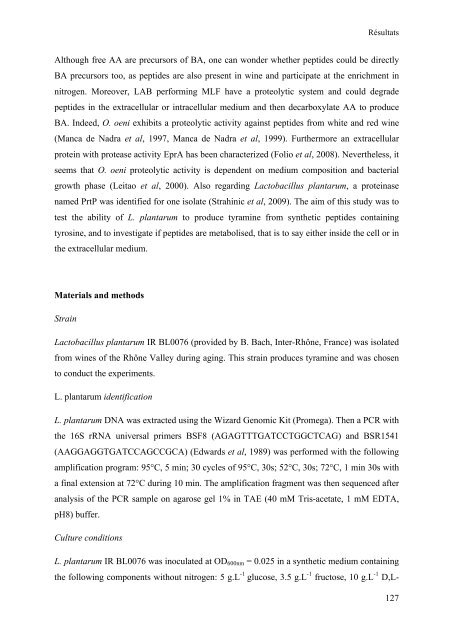THESE Maryse Bonnin Jusserand - Université de Bourgogne
THESE Maryse Bonnin Jusserand - Université de Bourgogne
THESE Maryse Bonnin Jusserand - Université de Bourgogne
You also want an ePaper? Increase the reach of your titles
YUMPU automatically turns print PDFs into web optimized ePapers that Google loves.
Résultats<br />
Although free AA are precursors of BA, one can won<strong>de</strong>r whether pepti<strong>de</strong>s could be directly<br />
BA precursors too, as pepti<strong>de</strong>s are also present in wine and participate at the enrichment in<br />
nitrogen. Moreover, LAB performing MLF have a proteolytic system and could <strong>de</strong>gra<strong>de</strong><br />
pepti<strong>de</strong>s in the extracellular or intracellular medium and then <strong>de</strong>carboxylate AA to produce<br />
BA. In<strong>de</strong>ed, O. oeni exhibits a proteolytic activity against pepti<strong>de</strong>s from white and red wine<br />
(Manca <strong>de</strong> Nadra et al, 1997, Manca <strong>de</strong> Nadra et al, 1999). Furthermore an extracellular<br />
protein with protease activity EprA has been characterized (Folio et al, 2008). Nevertheless, it<br />
seems that O. oeni proteolytic activity is <strong>de</strong>pen<strong>de</strong>nt on medium composition and bacterial<br />
growth phase (Leitao et al, 2000). Also regarding Lactobacillus plantarum, a proteinase<br />
named PrtP was i<strong>de</strong>ntified for one isolate (Strahinic et al, 2009). The aim of this study was to<br />
test the ability of L. plantarum to produce tyramine from synthetic pepti<strong>de</strong>s containing<br />
tyrosine, and to investigate if pepti<strong>de</strong>s are metabolised, that is to say either insi<strong>de</strong> the cell or in<br />
the extracellular medium.<br />
Materials and methods<br />
Strain<br />
Lactobacillus plantarum IR BL0076 (provi<strong>de</strong>d by B. Bach, Inter-Rhône, France) was isolated<br />
from wines of the Rhône Valley during aging. This strain produces tyramine and was chosen<br />
to conduct the experiments.<br />
L. plantarum i<strong>de</strong>ntification<br />
L. plantarum DNA was extracted using the Wizard Genomic Kit (Promega). Then a PCR with<br />
the 16S rRNA universal primers BSF8 (AGAGTTTGATCCTGGCTCAG) and BSR1541<br />
(AAGGAGGTGATCCAGCCGCA) (Edwards et al, 1989) was performed with the following<br />
amplification program: 95°C, 5 min; 30 cycles of 95°C, 30s; 52°C, 30s; 72°C, 1 min 30s with<br />
a final extension at 72°C during 10 min. The amplification fragment was then sequenced after<br />
analysis of the PCR sample on agarose gel 1% in TAE (40 mM Tris-acetate, 1 mM EDTA,<br />
pH8) buffer.<br />
Culture conditions<br />
L. plantarum IR BL0076 was inoculated at OD600nm = 0.025 in a synthetic medium containing<br />
the following components without nitrogen: 5 g.L -1 glucose, 3.5 g.L -1 fructose, 10 g.L -1 D,L-<br />
127

















